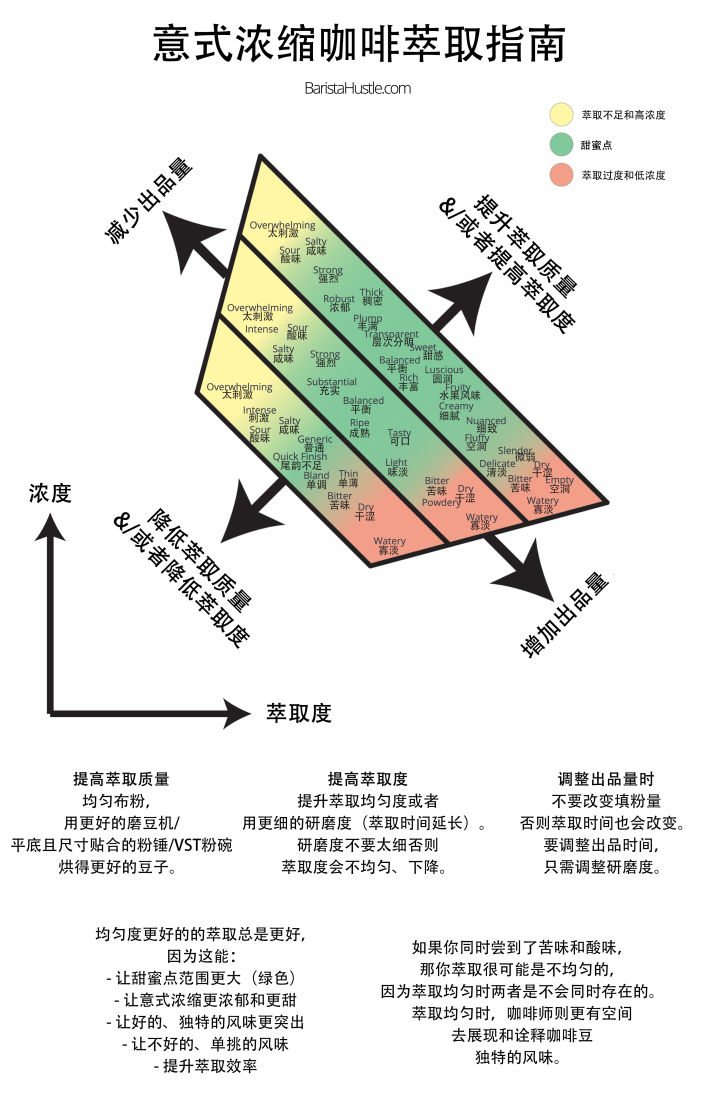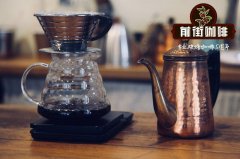What on earth is coffee extraction? How is espresso extracted? What is the rate of extraction?

Professional coffee knowledge exchange More coffee bean information Please pay attention to coffee workshop (Weixin Official Accounts cafe_style)
Coffee extraction_Standard espresso coffee extraction_Principles of coffee extraction_Coffee extraction methods
What is Coffee Extract? What exactly happened during the extraction? There is still a lot we don't fully understand about coffee extraction. Today, I'm going to share with you some of my experiments and experiences over the past few weeks, hoping to help you deepen your understanding of coffee extraction.
What we know about extraction
We all know that water is a very strong solution, and it can even be called a "universal solution" because it can dissolve many substances that other liquids cannot dissolve. The molecular structure of water must be known to all, composed of hydrogen atoms and oxygen atoms, with positive and negative polarity, it is precisely because of this, other substances and molecules in the water will easily decompose and combine with water molecules. On top of this, the extra heat makes the molecules move more violently, which makes hot water more capable of dissolving other substances.
At the same time, we also know that many substances in coffee are soluble, such as fruit acids, caffeine, oils, melanoids, carbohydrates and plant fibers. Each substance is dissolved at different times and rates, with different flavors. Only 30% of the substances are soluble in water, less than 20% have positive flavors, and the rest give coffee an extra bitter, papery or other negative flavor. Fortunately, these positive flavors dissolve first, and the negative flavors take longer to extract.
We also know that different substances are dissolved at different stages of brewing. Fruit acids and caffeine dissolve fastest, so if the brewing time is short, the coffee taste will be bright and thin. The next thing to be extracted are fats and oils, which determine the taste of coffee, but filter paper prevents oils from entering coffee, so the taste of hand-brewed coffee will be thinner than coffee brewed with metal filters. Melanoids, carbohydrates and plant fibers dissolve last. Melanoid is a by-product of the Maillard reaction and is responsible for the brown color of coffee. Carbohydrates and plant fiber make up more than half of coffee's composition and are insoluble in water. These last two substances often carry negative flavors, giving coffee an extra bitter, papery or earthy taste, but they are also important to the overall taste balance of coffee.
A very simple experiment can be done to see what substances are extracted at different stages of brewing. If you haven't tried it yet, please follow these steps:
Prepare to make an espresso and prepare 6 small cups at the same time. When the coffee begins to strain, let it flow into the first cup, and after 5-10 seconds, let it flow into the next cup, and so on, until the coffee is made according to the brewing recipe.
Sort the cups in order, and you'll notice that each coffee varies greatly in color alone, and presumably tastes differently. Due to the limited amount of coffee, I only made 3 full cups, but even so, I got very interesting results from the TDS readings for each cup.
As can be seen from the above graph, the extraction rate is very high at the beginning of coffee making (the first cup of coffee is extracted from the beginning to the total weight reaches 5 g), and then drops off very significantly.
I began to wonder: what would happen if I brewed it differently? The espresso extraction process is very short. What would their TDS readings look like if they were brewed in other ways with longer extraction times?
Which brings me to another question:
What is the rate at which each substance is extracted?
To do this, I first had to figure out the extraction rate of coffee, the total amount extracted during the whole process, and the ratio of the total amount of each substance extracted during the brewing process to the total weight of coffee.
To do that, I need to collect more data. I started experimenting with V60 hand-brewed coffee and recording sensory analysis data and TDS readings. The recipe I used was: 22.22g coffee and 400g water brewed in 5 minutes with a pre-brew time of 30 seconds. I chose a longer recipe to collect more data.
Every 30 seconds, I move the bowl to a new coffee cup, pouring 50 grams of water every 30 seconds. In the end, I got eight cups of hand-brewed coffee extracted every 30 seconds.
This approach may produce some errors, and I have tried every means to avoid them. For example, moving the filter bowl to a new coffee cup will cause extra vibration of the coffee powder. For example, I can only control the amount of water poured at each stage, but I can't accurately control the total amount of coffee dripped into the coffee cup. This may lead to uneven coffee in each cup, especially when I pour the last time, all the remaining water goes into the last cup, resulting in the last cup with the most coffee.
But the results are encouraging, both from sensory analysis and from refractometer readings. As can be seen from the above picture, the extraction rate of coffee is extremely high during the first 30 seconds of extraction, i.e. during the pre-brewing process. After that, the extraction rate will continue to increase to 1 minute, and then it will decline rapidly.
From the taste of coffee, we can also see the difference between each cup of coffee. As expected, the first two cups of coffee in the first minute are brightly-sour because fruit acids dissolve fastest. In the next few cups of coffee, we tasted brown sugar, molasses and toffee respectively. After 2 minutes, the coffee starts to turn vanilla, bitter and slightly astringent. The last minute coffee tastes bland, thin and watery.
I also found that the number of taste description words at each stage matched the trend of TDS readings very well, peaking at about a minute, when words were at their highest, and then falling rapidly, with words decreasing accordingly.
On top of that, I need to collect the total weight of coffee extracted every 30 seconds to calculate the extraction rate for each substance. To do this, I ran two more experiments, weighing each stage and collecting TDS readings to calculate the proportion of coffee in each stage to the total coffee weight.
The graph above shows the variation of TDS readings throughout the extraction. We can see that the extraction rate of coffee drops rapidly after the first 90 seconds, but the TDS reading as a whole is still steadily increasing. Although the TDS reading in the first stage is high, the amount of coffee extracted in the first 90 seconds is only a small fraction of the total amount of coffee, which is then diluted into the full cup.
Therefore, we can conclude that more than half of the soluble substances are extracted in the first 90 seconds of brewing, although this part of the coffee only accounts for 20% of the total amount of coffee.
The results of this experiment are very encouraging, but I still want to know more. What happens to the extraction rate of coffee if all the water is poured in at first? To that end, I experimented with steeped coffee.
At first I chose French coffee. To facilitate the experiment, I placed the filter under the coffee powder layer, rather than pressing it down after soaking in the traditional sense. It turned out to be a challenging method, and the results were not significant. Much like hand-brewed coffee, TDS readings rose rapidly in 30 seconds to 1 minute, then fell rapidly, and readings did not change at all in the interval of 1 minute to 4 minutes.
But we still tasted coffee extracted every 30 seconds, and we found that the results varied greatly. About 1 minute extraction of coffee taste acid, taste thin; in the middle of the coffee flower aroma is very strong, slightly alcohol flavor. If the TDS reading did not change after 1 minute, where did the change in taste come from?
To find out, I opted for a more flexible infusion device, the Clever coffee maker. This time, instead of changing cups frequently, I paused every 30 seconds to make eight cups of coffee. In addition, the Clever coffee pot can brew large amounts of coffee at once, so that I can conduct sensory analysis.
But sometimes the results of experiments are far from what we think. Even with the Clever coffee maker, TDS readings stopped increasing at a very early stage, with a difference of only 0.29 between TDS readings at 30 seconds and 4 minutes of brewing, and coffee TDS readings already reaching 1.06 in the first 30 seconds. Similarly, the taste of each cup of coffee still varies greatly.
What does the experiment suggest?
1. Most of the extraction occurred at the beginning of extraction, peaking at 1 minute
This may not be a new discovery, but we already know that positive flavors are extracted first in the initial stages of extraction, and that the subsequent extraction of melanoids, plant fibers, and carbohydrates can contribute bitter and negative flavors that affect the overall taste of coffee. But bitterness is also an important part of coffee taste balance and is indispensable.
Among other things, I was struck by the amount of material extracted in the first 30 seconds of coffee brewing. During sensory analysis, one of my colleagues looked at me in surprise and asked,"Do you know we're extracting coffee concentrate and diluting it?" Although he was exaggerating, what he said was not unreasonable. Most of the positive flavors of coffee are extracted almost instantaneously, and the concentration is extremely high, very unbalanced, and too outstanding. Coffee since then is an effort to balance these flavors and give coffee a stronger sense of structure.
2. TDS does not indicate whether coffee is delicious
In the infusion coffee experiment, we found that the coffee extraction rate reached a bottleneck after 1 minute of brewing. In hand brewed coffee, the extraction rate drops rapidly after 1 minute due to continuous pouring of hot water into the coffee. Experiments with both methods showed that most of the soluble substances in coffee had been extracted within about 1 minute of brewing.
But even if the TDS readings didn't change, the coffee taste changed dramatically.
What makes coffee taste different at different stages? One explanation is volatile aromas, which we can detect by NMR spectroscopy, but coffee contains at least 800 aromas, making it almost impossible to calculate precisely.
And here's another lesson: Numbers don't tell us everything about coffee. Many people these days rely on refractive refractometers and readings to judge whether coffee is good or bad. But our results show that even the most sophisticated technology cannot replace people's sensory experience. If we were to rely solely on numbers, we would never be able to fairly assess the quality of each cup of coffee. Coffee is the same with wayward works of art, is by using our whole body to feel, we can know the coffee hidden the deepest truth.
Even if you have the most advanced equipment, it will not replace your tongue. Therefore, the next time you encounter a brewing device, when you want to set the brewing recipe, you must remember that the data is only based on, and the final judgment is still your own, trust your senses and follow your heart to explore.
author
Sandra Loofbourow
What is Coffee Extract? Coffee extraction principle and extraction parameters explained
Important Notice :
前街咖啡 FrontStreet Coffee has moved to new addredd:
FrontStreet Coffee Address: 315,Donghua East Road,GuangZhou
Tel:020 38364473
- Prev

The meaning of being a barista every barista has to start with the most basic cleaning
Professional coffee knowledge exchange more coffee bean information please follow the coffee workshop (Wechat official account cafe_style) barista _ barista training _ barista skills movie "Coffee for one person". Suddenly there are a lot of young writers and artists in the store to discuss the characters and the plot. Except for everyone, whether everyone is waiting for a certain person, who that person is and how to extend the knowledge of philosophy.
- Next

What is the taste of excessive extraction of hand-brewed coffee? What are the reasons for the astringency of hand-made coffee?
Professional coffee knowledge exchange more coffee bean information please pay attention to coffee workshop (Wechat official account cafe_style) coffee extraction _ Italian coffee extraction standard _ coffee extraction principle _ coffee extraction method 1, coffee astringent performance: after drinking coffee, throat dry, astringent, astringent taste. I feel uncomfortable in my throat when I swallow the coffee. Coffee extraction
Related
- What is the meaning of lactic acid fermentation with coffee bean treatment?
- How to judge the state of foam by sound?
- How does the latte pull out the unicorn pattern? Come to get for a little trick to improve the flower pull!
- Will flower pulling affect the taste of the latte?
- Do you know the history of coffee?
- The difference between honey treatment and sun washing what is raisin honey treatment?
- What kind of milk can a novice use to make coffee foam to keep the foam longer? The correct method and skills of milking tutorial sharing
- Why do washed coffee beans taste sour? Flavor characteristics of washed Coffee
- Introduction to the skill of how to practice the size and height of water injection around the circle of hand-brewed coffee
- How do beginners practice coffee flower drawing from scratch?

